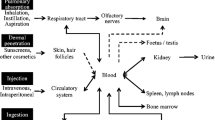Summary
The “in-vivo”-toxicity of the Vanadium-oxides V2O5 and V2O3 (administered orally, dermally and by inhalation) has been reinvestigated with particular emphasis on the safety and handleability of vanadium-oxides in the vanadium processing industry. Chemical-thermodynamic properties of vanadium-oxides make it likely that some earlier results on vanadium-toxicities have introduced artefacts as a consequence of the administration-techniques used. Special precautions have therefore been taken to avoid any chemical changes or artificial interactions during sample-preparation to ensure that the results significantly reflect the toxicities of the vanadium-compounds as exposure to them might occur. The LD50(14d)-values indicate, that V2O5 should be classified as “hamful” (V2O5 techn. grade fused oral LD50(14d): 716 mg/kg b.w. (rats m.) resp. 658 mg/kg b.w. (rats f.); inhal. LC50 16.2 mg/l (rats m.) resp. 4.0 mg/l (rats f.) for a 4-hour exposure), while V2O3 should be classified as “relatively non toxic” (V2O3 tech. grade powder oral: LD50(14d): 5639 mg/kg b.w. (rats f.) resp. 8713 mg/kg b.w. (rats m.)) according to the EEC-commission directive of July 29, 1983 (83/467/EEC). Based on interaction-studies and considering new results reported in literature, a 3-level-model of the mechanism of vanadium-toxicity via oxygen-radicals is suggested.
Zusammenfassung
Die “in-vivo”-Toxizität der Vanadium-Oxide V2O5 und V2O3 bei oraler, dermaler und inhalativer Applikation wurde neu untersucht. Aufgrund einer Analyse der chemisch-thermodynamischen Eigenschaften dieser V-Oxide wird nahegelegt, daß die Resultate einiger früherer Toxizitätsuntersuchungen durch chemische Veränderungen der zu untersuchenden Stoffe bei der Probenvorbereitung verfälscht wurden. Nach den in-vivo-LD50(14d)-Werten ist V2O5 als “mindergiftig” (V2O5 techn. “fused” oral LD50(14d): 716 mg/kg b.w. (Ratten m.) bzw. 658 mg/kg b.w. (Ratten w.); inhalotiv LC50 16.2 mg/l (Ratten m.) bzw. 4.0 mg/l (Ratten w.) for a 4-hour exposure) bzw. V2O3 (techn. pulv. peroral LD50(14d): 5639 mg/kg KG (Ratten w.) bzw. 8713 mg/kg KG (Ratten m.) als relativ nicht toxisch-nicht klassifiziert gemäß EEC-Commission-Directive vom 29. Juli 1983 (83/467/EEC) einzustufen. Basierend auf Studien der Interaktionswirkung bestimmter Substanzen und unter Eibeziehung der Resultate jüngst mitgeteilter Befunde zur Vanadium-Toxizität an Zellkulturen, wird ein Modell zum Vanadium-Toxizitäts-Wirkungsmechanismus vorgeschlagen, das 3 Hauptmechanismen — abhängig von der Konfrontations-Intensität (Konzentration und Expositionsdauer) — nahelegt.
Similar content being viewed by others
References
Cotton F. A., Wilkinson G. (1967) Anorg. Chem.: 757
Michels S. (1973) Staub-Reinhalt. Luft33: 276
Kettle E. H., Hilton R. (1932) LancetI: 1190
Massmann W., Opitz H. (1954) Arch. Gewerbepath. Gewerbehyg.13: 353
Valentin H., Schaller K. H. (1976) Jahresbericht über die 16. Tagung der deutschen Gesellschaft für Arbeitsmedizin e. V., Köln, pp. 41–47
Symansky H. (1939) Arch. Gewerbepath. Gewerbehyg.9: 295
Massmann W. (1956) Arch. Toxikol.16: 182
Popper H. H. (1991) Abschlußbericht Projekt 3400. Jubiläumsfonds der Österreichischen Nationalbank, Wien; (1992) Environment, Hyg.; private commun.
Gmelins Handbuch der Anorganischen Chemie: Vanadium (1967) Teil B, Lieferung 1: V(B) 74–54; V(B) 212
d'Ans-Lax (1967) Taschenbuch für Chemiker und Physiker, Vol. 1, 3rd Ed. Springer, Berlin Heidelberg New York, 1/576–1/578
Kortüm G. (1962) Lehrbuch der Elektrochemie, 3. Aufl. Verlag Chemie, Weinheim, pp. 191, 325
Gould E. S. (1964) Mechanismen und Strukturen in der organischen Chemie. Verlag Chemie, Weinheim, pp. 307, 353
Haschke H. (1972) Monatsh. Chem.103: 525
Haschke H. (1973) Das Papier27: 490
Alberts B., Broy D., Lewis J., Roff M., Roberts K., Watson J. D. (1990) Molekularbiologie der Zelle, 2. Aufl. VCH, Weinheim
Syga G. (1978) Felduntersuchung zur beruflichen Vanadium-Exposition. Universität Erlangen-Nürnberg
Troppens H. (1969) Dt. Gesundheitswes.24: 1089
Vintinner F. J., Vallanas R., Carlin C. E., Weiss R., Macher C., Ochoa R. (1955) A.M.A. Arch. Industr. Hlth.12: 635
Rockhold W. T., Talvitie N. A. (1956) Clin. Chem.2: 188
Williams N. (1952) Brit. J. Ind. Med.9: 50
Lewis C. E. (1959) A.M.A. Arch. Ind. Hlth.19: 419
Zenz C., Berg B. A. (1967) Arch. Environ. Hlth.14: 709
Watanabe H. (1966) Jap. J. Ind. Hlth.8: 23
Köhler R. (1972) Dt. Gesundheitswes.27: 815
Schaller K. H., Küchle W., Holzhauser K. P., Valentin H. (1976) Jahrestagung der Dt.Ges.f. Arbeitsmed., München, Apr. 1975. Gentner-Verlag, Stuttgart
Köhler R. (1970) Z. ges. Hyg.16: 7
Bachmann H. G., Ahmed F. R., Barnes W. H. (1961) Krist Z.115: 130
Byström A., Wilhelmi K. A., Brotzen O. (1950) Acta Chem. Scand.4: 1119, 1126
May K. R. (1975) J. Aerosol. Sci.6: 413
Lichtfield J. T., Wilcoxon F. (1949) J. Pharmacol.95: 99
Finney D. J. (1971) Probit Analysis, 3rd Ed. Cambridge University Press, Cambridge
Mountain J. T., Stockell Jr. F. R., Stokinger H. E. (1953) A.M.A. Arch. Ind. Hyg. Occup. Med.8: 406
Mountain J. T., Stockell Jr. F. R., Stokinger H. E. (1955) A.M.A. Arch. Ind. Health12: 494
Mascitelli-Coriandoli E., Citterio C. (1959) Nature183: 1527
Mascitelli-Coriandoli E., Citterio C. (1959) Nature184: 1641
Curran G. L. (1954) J. Biol. Chem.210: 765
Missenard C., Hansen G., Kutter D., Kremer A. (1989) Brit. J. Industr. Med.46: 744
Sabbioni E., Maroni M. (1983) Final Report. Commission of the European Communities, Directorate-General of Science, Research and Development. EUR 9005 EN
Todaro A., Bronzato R., Buratti M., Colombi A. (1991) La medicina del lavoro 82: 142
Author information
Authors and Affiliations
Rights and permissions
About this article
Cite this article
Leuschner, J., Haschke, H. & Sturm, G. New investigations on acute toxicities of vanadium oxides. Monatsh Chem 125, 623–646 (1994). https://doi.org/10.1007/BF01277622
Received:
Accepted:
Issue Date:
DOI: https://doi.org/10.1007/BF01277622




